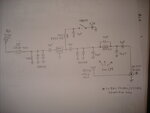neazoi
Advanced Member level 6
Hello,
I have a handheld transceiver that transmits on V/U and receives wideband.
This is my idea in connecting an HF+50MHz active antenna in parallel, whereas at the same time be able to transmit from the main antenna at V/U, without the HF active antenna to be affected.
What do you think of my idea?
I wirry about the parallel connection of the antennas, what happens to the impedance at this point and will this affect reception and transmission much?
I have a handheld transceiver that transmits on V/U and receives wideband.
This is my idea in connecting an HF+50MHz active antenna in parallel, whereas at the same time be able to transmit from the main antenna at V/U, without the HF active antenna to be affected.
What do you think of my idea?
I wirry about the parallel connection of the antennas, what happens to the impedance at this point and will this affect reception and transmission much?
